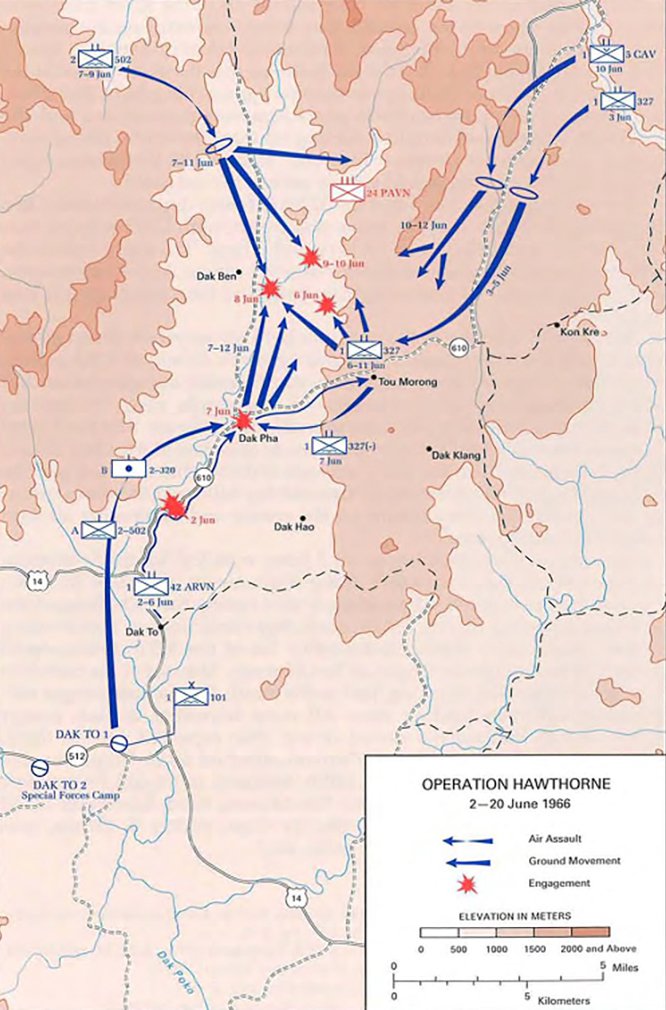Week of June 23
Week of June 23
On June 20, 1966, U.S. and South Vietnamese troops concluded Operation HAWTHORNE after nearly three weeks of heavy fighting. It was an operation in Kontum Province during a year of the war in which U.S. forces broadly took the offensive against Communist troops for the first time. The original goal of Operation HAWTHORNE was to relieve a garrison of South Vietnamese Regional Forces that had been surrounded near Đăk Tô. But captured intelligence suggesting an imminent North Vietnamese offensive in the province led to HAWTHORNE’s expansion in order to spoil Hà Nội’s attack plan.
In late May 1966, at an outpost in northern Kon Tum Province named Tou Morong, North Vietnamese troops surrounded a group of South Vietnamese Regional Forces, cutting off their escape routes. The defenders of Tou Morong remained pinned down by mortar and sniper fire for several days, but their position was not overrun. This was likely because the North Vietnamese intended the attack on Tou Morong as a distraction (as captured intelligence soon indicated) for an imminent offensive by the North Vietnamese 88th and 24th Regiments, which were lurking nearby. If the larger attack had been launched, it would have been one of the first major North Vietnamese offensive operations since the arrival of American combat troops.
If a plan for an offensive existed, however, allied forces spoiled it. In response to the Tou Morong attack, the U.S. Army launched Operation HAWTHORNE on June 2, to relieve Tou Morong and to counter any notion Communist troops might have had of a wider attack in Kon Tum.
Operation HAWTHORNE began on June 2, 1966. Participating forces included the 1st Brigade, 101st Airborne Division; a South Vietnamese infantry battalion; and the South Vietnamese 21st Ranger Battalion. These units were later joined by the U.S. 502d Infantry Regiment. HAWTHORNE’s forces moved into a region of mountainous thick jungle with few serviceable roads, aiming to destroy the North Vietnamese 24th Regiment from three sides (the 88th Regiment was still waiting across the border, in Laos). The allied forces reached the surrounded men at Tou Morong relatively quickly, relieving them on June 5.
American commanders decided to see if they could track down the North Vietnamese before they left the region. After a short pursuit, a series of major engagements and minor skirmishes occurred between allied troops and the North Vietnamese 24th Regiment over the following days, as U.S. and South Vietnamese forces, now joined by the 502d Infantry, pushed north and west through the jungle. The Communist forces retreated into a prepared defensive position and readied themselves for a long fight. But, after U.S. attacks triangulated the North Vietnamese’s precise position, American commanders requested a B-52 strike. On June 13, an Arc Light strike force of U.S. Air Force B-52s dropped nearly 650 tons of bombs on the North Vietnamese 24th Infantry Regiment and its fortified base area. A follow up ground attack found that the Communist forces had been devastated.
After several days of further skirmishes, Operation HAWTHORNE ended on June 20, having chased the remaining Communist soldiers into Laos and perhaps ending a North Vietnamese offensive before it began. Later estimates indicated that the 24th Regiment had sustained a casualty rate of 60 percent, and because of this U.S. leaders judged HAWTHORNE a success, though the North Vietnamese Regiment was back to fighting strength by early 1967. American casualties in HAWTHORNE included 48 killed, and 239 wounded.1
1John M. Carland, United States Army in Vietnam: Combat Operations: Stemming the Tide, May 1965 to October 1966 (Wash DC: Center of Military History, 2000), 276–88; Spencer C. Tucker, The Encyclopedia of the Vietnam War: A Political, Social, and Military History (2nd edition; Santa Barbara, CA: ABC-CLIO, 2011), 465–66.

|
Map of Operation HAWTHORNE, from Carland, Stemming the Tide, p. 278